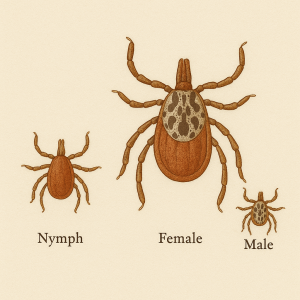Description & Other Names
The Gulf Coast tick (Amblyomma maculatum) is in the same genus as the Lone Star tick (Amblyomma), but instead of a dot, it has a pretty ornate pattern. These ticks are similar in size to American dog ticks (maybe a tad smaller on average), but in the same ballpark. They have ornate silvery-white patterns on a dark background on their backs (more elongated patterns rather than the kind of mottled look of a dog tick). To an untrained eye, they might be mistaken for American dog ticks because both have decorative markings. Gulf Coast ticks have longer mouthparts than dog ticks. They are called Gulf Coast ticks because they were historically found along the Gulf of Mexico coast, but they’ve spread inland.
Where Found
As the name implies, they are primarily found in the Southeastern U.S., especially near the Gulf Coast. This includes states like Florida, Alabama, Mississippi, Louisiana, Texas – but also along the Atlantic coast up through the Carolinas. In recent years, they have been found in focal areas of the Mid-Atlantic and even parts of Kansas, Oklahoma, etc. So their range has been expanding north and inland. They like warm, grassy habitats, including coastal marshes, prairies, and pastures. They can tolerate drier environments, often found in prairies of Oklahoma or Kansas now. So not just the “Gulf Coast” anymore despite the name. In places like eastern North Carolina’s coastal plain, Gulf Coast ticks are present. They are not as widespread as dog ticks, but you might encounter them in the South central and Southeastern states.

Diseases Spread
The main disease associated with Gulf Coast ticks is Rickettsia parkeri rickettsiosis (that’s a mouthful) Basically it’s a spotted fever group rickettsial infection caused by Rickettsia parkeri. Some people call it American Boutonneuse Fever or just call it R. parkeri infection. It’s similar to Rocky Mountain Spotted Fever but typically milder. It often causes an eschar (a dark scab) at the bite site and a fever/rash illness, but generally less severe than RMSF (fewer fatalities, responds well to doxycycline). Still not fun, but not as dangerous usually. Gulf Coast ticks do not transmit Lyme or ehrlichiosis. There’s some evidence they can carry Heartwater disease (which affects livestock) and some other spotted fevers. But for human health, R. parkeri is the one to note. It’s possible some cases of “mild RMSF” in the Southeast in the past were actually R. parkeri from Gulf Coast ticks before this was recognized. As of now, R. parkeri rickettsiosis is mainly reported in Gulf Coast states and is still relatively infrequent, but definitely present.
Active Season
Gulf Coast ticks are most active in warm months. In places like Florida, they can be active nearly year-round. In more seasonal climates like the Southern Plains or Carolinas, they’ll be out spring through fall. Adults are often found in summer. There’s not as much public data on exact peaks, but suffice it to say when it’s tick season in the South (April-September), Gulf Coast ticks could be questing. They, like dog ticks, often inhabit grassy areas. In fact, in some regions you might have both species in the same field.
How to Identify
Gulf Coast ticks look a lot like American dog ticks at first glance. Both are brown ticks with ornamentation. Gulf Coast ticks tend to have more vivid, larger silver markings. One distinctive feature: the ornate pattern on the shield of Gulf Coast tick often has a pattern of lighter color along the margins. Honestly it takes a keen eye or microscope to be certain. But consider geography: if you’re along the Gulf Coast or lower Atlantic coast, or in certain areas of Oklahoma/Kansas, a tick with ornate markings might be Gulf Coast tick. If you’re in say, Pennsylvania, any ornate tick is almost surely a dog tick (since Gulf Coast ticks aren’t up there). If you can see the mouthparts, Gulf Coast ticks have longer mouthparts than dog ticks (more like the Lone Star tick’s long mouthparts). Dog tick mouthparts are short. Also, male Gulf Coast ticks have more extensive ornamentation than male dog ticks (dog tick males are kind of mottled all over with no distinct pattern, whereas Gulf Coast male has bold markings). It might be easiest to distinguish by what diseases develop: if a tick bite in a Gulf Coast area gives you a mild spotted fever with an eschar, that points to R. parkeri and thus Gulf Coast tick. But of course, you want to ID the tick before you get sick ideally! In short: Location, location, and location. Gulf Coast ticks in the Southeast coastal and adjacent states; dog ticks more widespread. To be safe, if you’re bitten by any ornate tick in the South, monitor for spotted fever symptoms and see a doctor if fever or rash develops.


